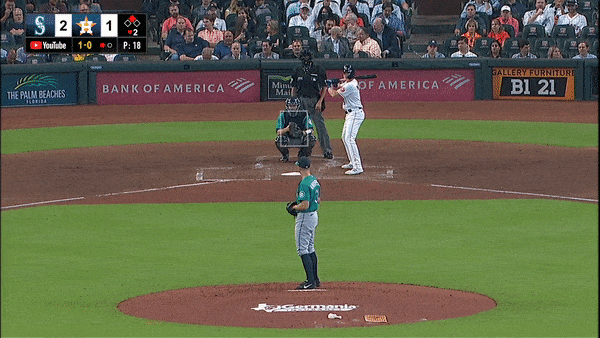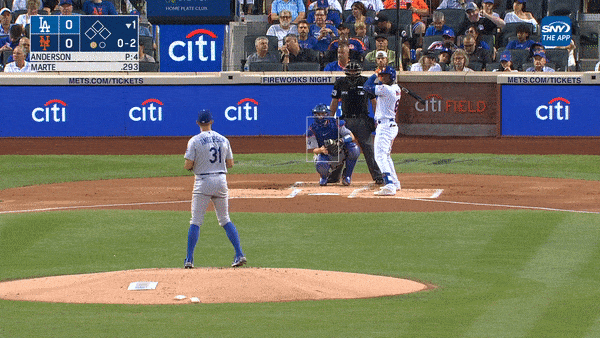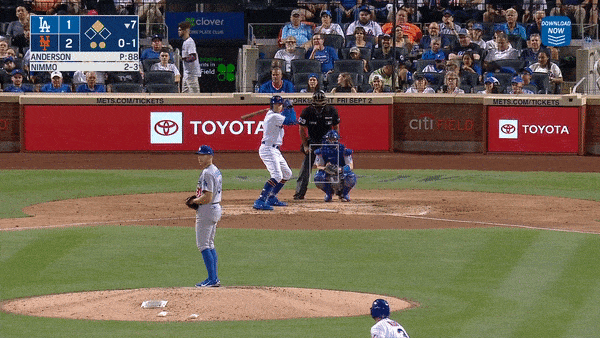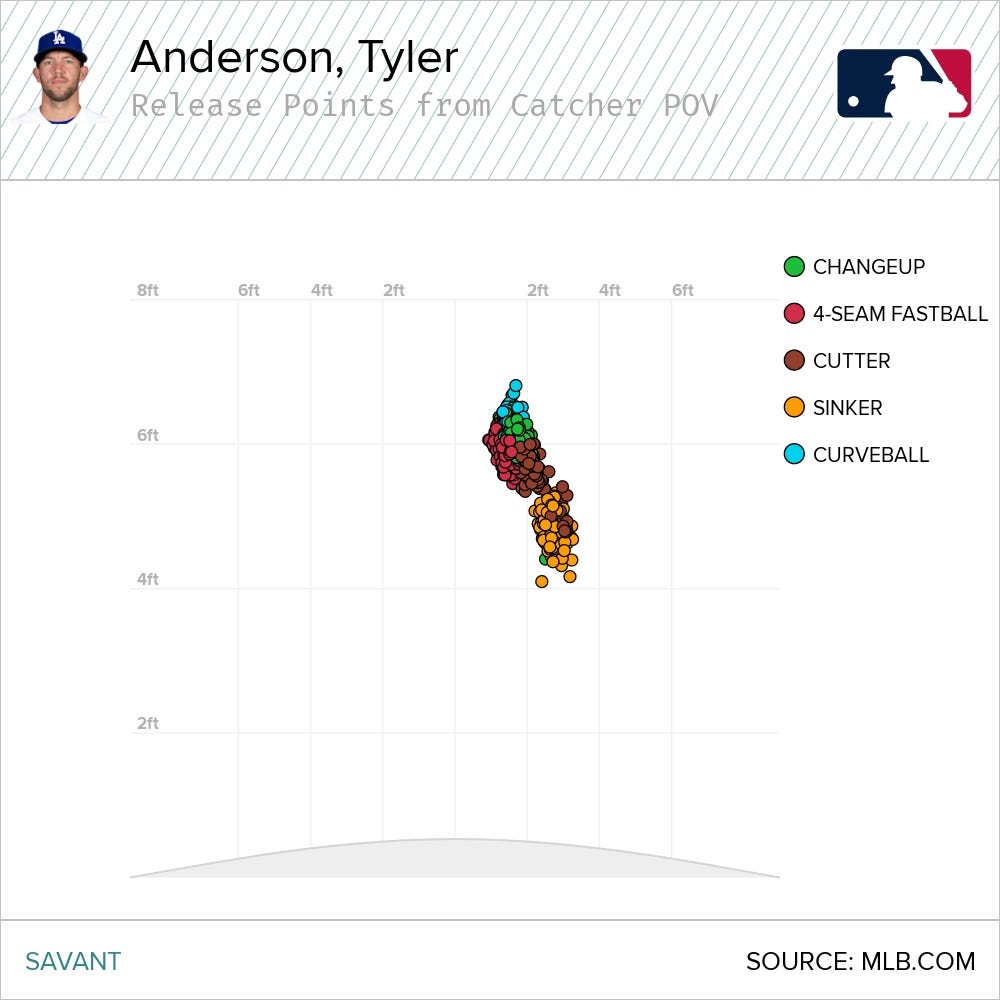Royals free agent target: Tyler Anderson
The lefty had a breakout season for the Dodgers and hits the free agent market as an attractive option for teams looking to supplement their starting rotation.
As the Royals turn their focus to 2023, an area of need is starting pitching. This isn’t any kind of newsflash.
Last summer the Royals received just north of 830 innings from their rotation. That was close to the league average when it came to starter’s workload. That’s fine, but the results of those innings…ick.
The rotation was Brady Singer and Zack Greinke. The remainders were offerings to the Baseball Gods and the Gods were not pleased. Royals starters’ ERA was 4.76, the worst in the American League. The Reds, Rockies and Nationals were the only teams that finished with a worse ERA than the Royals.
Yes, as the Royals cast a search for a pitching coach, they desperately need to supplement their rotation with capable arms. It’s possible they attempt to solve the problem by swinging a trade. General manager J.J. Picollo has tried to dampen free agent expectations, but it’s safe to assume that if an opportunity presents itself, the Royals will—and more importantly, can—make a move.
First up in a series of posts of potential free agent targets for the Royals this winter is left-handed starter Tyler Anderson.
This isn’t Anderson’s first dip into the free agent pool. In fact, it’s his fourth time on the open market. He was briefly a free agent after the 2019 season when he was picked up off waivers by the Giants. Eligible for arbitration for the second time in his career and coming off that season where the knee injury allowed him to throw only 20 major league innings, he was non-tendered. However, the Giants immediately signed him to a one-year deal for a pay cut of close to a cool $1 million.
The Giants non-tendered him again after the Covid 2020 season. He was signed by the Pirates for $2.5 million for a year. Pittsburgh, doing what perpetually rebuilding teams should be doing, dealt Anderson in late July to the Mariners. Out of contract again following the 2021 season, he struck the pitching motherlode, a one-year deal for $8 million with the Dodgers.
This seems an ideal spot to drop some numbers.
When the Royals go searching for a pitching coach and start laying the foundation for what should be a pitching lab, I would humbly submit they try to emulate whatever is happening in Chavez Ravine.
Anderson has had three seasons where he’s thrown 167 or more innings: One in Colorado, one split between Pittsburgh and Seattle and then last year in Los Angeles. In his first two of these seasons, he was roughly a league-average starter. It’s kind of wild how those two seasons mirror each other given they came three years apart.
And then 2022 happened. How, exactly? I’m glad you asked.
The Changeup
While Anderson’s best pitch has generally been his changeup, that—as you can tell from the statistics posted above—is kind of relative. It’s his best pitch, but historically, it was far from an offering that ever gave him much of an edge.
Until 2022.
Anderson sliced a couple of MPH off his change last season. The result was a pitch that featured a lot more tumble. In the past, his cambio had somewhere between 25 to 29 inches of vertical drop on a pitch that averaged around 81 MPH. In 2022, Anderson’s change was coming in at about 79 MPH and featuring 35 inches of vertical drop.
Let’s just go to the gifs…
Here’s Anderson’s change from the 2021 season.
And from 2022.
The camera angles are different, but the pitches land in the same zone, per Baseball Savant. The routes the two changeups took to arrive at their destination…vastly different.
The change from 2021 had some nice fade. Kind of the traditional “pull the string” off-speed pitch. The change from 2022 had some drop.
Batters hit .250 with a .488 slugging percentage against the Anderson change in 2021. Those numbers aren’t that off from what he posted throughout his career overall with the pitch. In 2022 however, Anderson flummoxed batters to a .179 batting average and .262 slugging percentage versus the change. The extra five to eight inches of drop turned the pitch from an averageish offering to something borderline elite.
Don’t forget the drop in velocity! Anderson throws a four-seamer around 91 MPH. In the past, the difference between that pitch and his change was around nine MPH. Last year, it was 11 MPH. More velocity separation and more drop turned the Anderson cambio into a weapon.
The sinker
I’m just going to drop this gif from last summer right here. It’s from the same game as the above 2022 gif for a little consistency's sake. You’re going to spot a fairly obvious difference.
I mean, that release point…Anderson really drops down when he slings the sinker. He only offered it seven percent of the time last year and threw it too often to right-handed batters. But coming in against the lefty as you can see above…That pitch has some potential.
This chart of Anderson’s release point for all pitches he throws is enough to keep me entertained for quite some time.
He’ll mix in a cutter from that lower angle from time to time. I also spy a changeup from that same arm slot. That’s some quality deception. The alteration in release point wasn’t something unlocked by his arrival in LA. That was something Anderson started doing in 2021 when he split his time between Pittsburgh and Seattle.
It’s a fun wrinkle, but one that’s not particularly effective. Left-handed batters hit .296 with a .370 slugging percentage on Anderson’s sinker. Righties hit .266 with a .577 slugging percentage. So a few more singles for lefties, but quite a bit more power from the right side of the plate. If Anderson’s sinker could be refined just a bit and used a little more exclusively against hitters from the same side the way his change is used primarily against right-handed hitters, there could be a little something there.
The highlights
Here’s a reel of Anderson dominating the Padres in Game Four of the NLDS. He threw five shutout innings, allowing two hits and two walks while striking out six.
The profile
Anderson had a ground ball rate of 41 percent last year, which was right in line with his career rate. It’s a few points below the league average. His 27 percent fly ball rate is slightly above league average, which as we all know would play well at Kauffman Stadium. One thing that really stands out from his 2022 season was his 6.4 percent HR/FB rate. That’s insane and highly unsustainable.
Maybe part of the reason he was able to keep those fly balls in the yard was the fact his hard hit rate (batted balls with an exit velocity greater than 95 MPH) dropped a whopping four and a half percentage points from 2021. His average exit velocity fell from 87 MPH to 85 MPH. That’s significant. I think part of that was his reliance on his change with the stronger vertical break. He threw his changeup 32 percent of the time last year, up from 25 percent the year prior.
That cambio led him to a 35 percent chase rate, the highest of his career. It’s fair to say everything hinges on the changeup. In addition to the soft contact, his pop up rate hit double-digits.
He finished with 4.0 fWAR last year, his highest mark since his rookie campaign in 2017. Almost double what he posted in 2021.
Everything worked for Anderson in 2022. It’s unlikely the pitching planets will align this way again, but the foundation is there for some success that would justify awarding him a two or three-year deal. Speaking of which…
The contract
As I was writing this, this Tweet popped up:

Between this and the rumor that the Rangers will do the same with their free agent starter Martín Pérez, I’m left wondering what the hell is going on. (That’s kind of my general mental state during the winter.) I’ve spent the previous 1,000 or so words explaining how Anderson is a good, not great, starting pitching option and one who continues to have some potential yet to be unlocked. Even if the Dodgers were confident they could coax more out of him, Anderson’s track record doesn’t exactly lead one to project a $19.65 million contract. Even if it’s just for one year.
It’s just money, I suppose. The Dodgers have plenty. It’s not difficult to imagine that if they rolled a wheelbarrow full of cash in front of Anderson, he would jump into it. That could render everything in this post moot. Such is the danger of writing about free agents.
If Anderson declined the offer, I would think it would adversely impact his market. He would cost the Royals their third-round pick in the 2023 draft were he to sign with Kansas City. When I started writing this, I was envisioning something along the lines of a two-year deal at an AAV of around $14 million. He will be 33 next year and has, outside of his breakout last summer, been a largely league-average starter. A qualifying offer changes everything. If that happens, I would assume Anderson accepts, tries to replicate his successes from ‘22 and then strike an even larger payday hitting the market a year later and without the QO. If he declines, I would expect teams to be hesitant to surrender a draft pick for two or three years from a starting pitcher.
The deadline for teams to extend the qualifying offer is Thursday.
Anderson is a nice low-risk acquisition as he wouldn’t require a long-term contract, nor would he blow the budget out of the water. With the Royals reportedly looking to keep payroll at 2022 levels, Anderson could step in and provide some coverage. While it’s unlikely he will repeat the 2022 success he had with the Dodgers, he could provide something of a stop-gap option as the Royals try to revamp their own pitching development program.











QO makes sense to me if you're the Dodgers. He's coming off a 4.0 fWAR season, but probably doesn't have the track record to turn it down. It could also be gamesmanship, hoping that they can use that carrot to get him to sign a 3-year/$45M deal to guarantee more money with less of an annual CBT hit. They had so many issues with health in their rotation, and I don't think they balk at spending ~$20M on just a one-year deal to bring back a pitcher who can get them over until Walker Buehler is back.